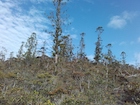
Trees in habitat, New Caledonia [Romain Barrière 2020].

Trees in habitat, New Caledonia [Romain Barrière 2020].

Tree at the Brisbane Botanical Garden, Queensland [C.J. Earle, 1996.03.31].

Foliage on the above tree [C.J. Earle, 1996.03.31].

Bark of a tree growing at 700 m elevation on Mt Panie in New Caledonia [Phill Parsons].

Conservation Status

Araucaria montana
Brong. & Gris 1871
Common names
Mountain araucaria (Silba 1986).
Taxonomic notes
Synonym: Eutassa montana (Brongn. et Gris) de Laub. 2009. A molecular analysis places Araucaria montana into the clade of large-leaved species of New Caledonia, along with A. biramulata, A. humboldtensis, A. laubenfelsii, A. muelleri, and A. rulei (Gaudeul et al. 2012).
Description
Monoecious evergreen trees to 40 m. tall, with a columnar crown. Branches numerous and spreading, 15-22 mm in diameter. Bark dark brown or gray, exfoliating in thin strips or scaly. Juvenile leaves scale-like, non-flattened, ovate, lanceolate, 10 × 4-5 mm, apex incurved. Adult leaves scale-like, bluntly acute to obtuse, ovate, 11-14 × 7-8 mm, loosely imbricate, apex incurved, midrib prominent. Pollen cones cylindrical, 8-13.5 cm by 20-28 mm, scales triangular, pollen sacs 12, microsporophylls triangular. Seed cones 8-9 × 6-8 cm; bracts short and acuminate, 5-10 mm long. Seed to 3.2 cm long, with oval wings and an elongated nut. Germination epigeal (Silba 1986). See García Esteban et al. (2004) for a detailed characterization of the wood anatomy.
Distribution and Ecology
N New Caledonia, type near Canala, 200-1400 m (Silba 1986). Rigg (2005) describes how this species occurs on ultramafic soils in both maquis and as an emergent in upland rainforest. In both habitats it evidently regenerates more or less continuously in response to small-scale disturbances including fire (in maquis) and blowdown (in maquis and rainforest).
This maps shows herbarium records of Araucaria species native to New Caledonia. Letter corresponds to first letter of species epithet (A. goroensis coded as A. muelleri, see A. goroensis for discussion) with different colors for species having same first letter; A. montana is orange. Click on an icon for further information. Distribution data from GBIF (2020.03.30), edited to remove duplicates.
The IUCN reports that the population is facing a high risk of extinction in the wild due to a limited and severely fragmented distribution that is forecast to experience continued decline in extent of habitat, number of subpopulations, and number of mature individuals.
Remarkable Specimens
No data as of 2023.02.23.
Ethnobotany
No data as of 2023.02.23.
Observations
No data as of 2023.02.23.
Remarks
Citations
Brongniart, A. and J. A. A. Gris. 1871. Ann. Sci. Nat., Bot. sér. 5, 13: 358. Available: Biodiversity Heritage Library, accessed 2023.03.04.
Gaudeul, M., G. Rouhan, M.F. Gardner, and P.M. Hollingsworth. 2012. AFLP markers provide insights into the evolutionary relationships and diversification of New Caledonian Araucaria species (Araucariaceae). American Journal of Botany 99(1):68-81.
Rigg, L.S. 2005. Disturbance processes and spatial patterns of two emergent conifers in New Caledonia. Austral Ecology 30(4):363-373.
See also
Association Endemia, a site devoted to New Caledonian species. Has excellent photos, a range map, and other information. In French.
The species account at Threatened Conifers of the World.





